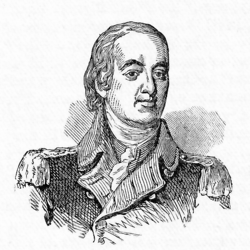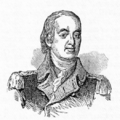William Alexander, Lord Stirling facts for kids
Quick facts for kids
William Alexander
|
|
|---|---|
 |
|
| Born | 4 December 1726 New York City, Province of New York |
| Died | 15 January, 1783 (aged 56–57) Albany, New York, U.S. |
| Allegiance | |
| Service/ |
|
| Years of service | 1775–1783 |
| Rank | Major General |
| Commands held | 1st New Jersey Regiment Continental Army (2 months) |
| Battles/wars | American Revolutionary War: • Battle of Long Island • Battle of Trenton • Battle of Brandywine • Battle of Germantown • Battle of Monmouth |
| Spouse(s) |
Sarah Livingston
(m. 1747) |
| Relations | Philip Livingston (father-in-law) William Livingston (brother-in-law) |
William Alexander (1726 – 15 January 1783) was an important American military leader. He was a major general during the American Revolutionary War. He was also known as Lord Stirling because he believed he was the rightful heir to a Scottish noble title.
Lord Stirling led soldiers bravely at the Battle of Long Island. He was captured, but his actions helped General George Washington's army escape. After being exchanged for another prisoner, he was promoted. He continued to serve with honor throughout the war. Washington trusted him greatly. In 1778, he helped expose a plot against Washington called the Conway Cabal.
Contents
Early Life and Family
William Alexander was born in New York City in 1726. He was a smart person who was good at mathematics and astronomy. He worked with his mother, Mary Alexander, in a successful business.
In 1747, he married Sarah Livingston. Her father was Philip Livingston (1686-1749). Her brother was Governor William Livingston. William and Sarah had two daughters, Mary and Catherine. Mary married a rich merchant named Robert Watts. Catherine married Congressman William Duer.
Claiming a Noble Title
William Alexander's father, James Alexander, had left Scotland. He did not try to claim the Scottish title of Earl of Stirling. After his father died, William decided to try. He believed he was the true heir to the title.
A Scottish court agreed with him in 1759. So, William started calling himself the Earl of Stirling. However, the House of Lords in England later disagreed. They said he could not use the title in 1762. Even so, he continued to be known as "Lord Stirling."
Stirling inherited a lot of money from his father. He invested in mining and agriculture. He lived a fancy lifestyle, which was quite expensive. He built a large estate in Basking Ridge, New Jersey. George Washington visited him there many times. In 1767, he even won a gold medal for growing grape vines on his estate.
Fighting in the American Revolution
When the American Revolutionary War began, Stirling joined the New Jersey colonial militia. He was made a colonel. He was wealthy and used his own money to help the Patriot cause. He showed his bravery early on by capturing a British naval ship.
In March 1776, the Second Continental Congress made him a brigadier general in the Continental Army.
The Battle of Long Island
In August 1776, Lord Stirling fought bravely at the Battle of Long Island. He led the 1st Maryland Regiment against a much larger British force. His troops fought hard, even though they were greatly outnumbered. This gave General Washington's main army time to escape.
Stirling was captured during this battle. But his actions were praised by both Washington and the British. One newspaper even called him "the bravest man in America." A monument now stands in Brooklyn to honor the Maryland soldiers.
Trusted General
After being exchanged for a British governor, Stirling was promoted. He became a major general. He was one of Washington’s most trusted generals. Washington even put Stirling in charge of the entire Continental Army for almost two months.
At the Battle of Trenton in December 1776, he accepted the surrender of a German mercenary regiment. He also fought in important battles like Brandywine and Germantown in Pennsylvania. He also fought at Monmouth in New Jersey. These battles showed his bravery and good judgment.
During the harsh winter at Valley Forge, his military headquarters were preserved. In January 1780, he led a raid against Staten Island. Lord Stirling also helped expose the Conway Cabal. This was a secret plot to remove Washington as commander.
In 1781, Washington and the French general Comte de Rochambeau moved their armies south. They went to fight the final Battle of Yorktown. Stirling was left in command of the Northern Army. He was sent to Albany, New York.
Later Life and Legacy
By this time, Lord Stirling was in poor health. He suffered from severe gout and rheumatism. He died in Albany on January 15, 1783. This was just months before the war officially ended with the Treaty of Paris. He was buried in the churchyard of Trinity Church in New York City.
Many places and people are named after him:
- Stirling, New Jersey, is near his old home.
- The Lord Stirling School in New Brunswick, New Jersey is named for him.
- Lord Stirling Park in Basking Ridge, New Jersey, is on part of his estate.
- The Sterling Hill Mine was named after him.
- William Alexander Middle School (MS51) in Brooklyn is named in his honor.
Images for kids


